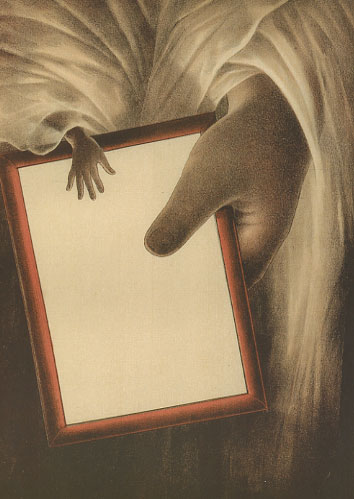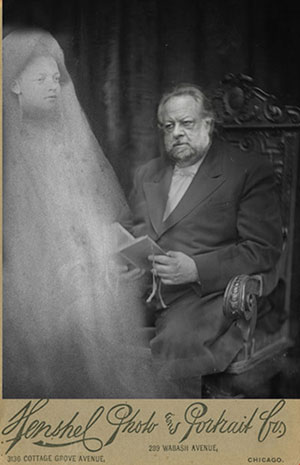
Ricky Jay
Twixt Two Worlds
October 6 - November 26, 2005
The Christine Burgin Gallery is pleased to announce the opening on October6, 2005 of "Twixt Two Worlds," an exhibition curated by Ricky Jay and drawnfrom his extensive collection of material related to the history ofdeception. Alternately titled "The Uninvited Guest: A Magician at theSéance," the exhibition will explore the complicated and revealingrelationships between magicians and mediums at the height of thespiritualism movement during the mid to late 19th century. Mediums stealingtricks from magicians, magicians debunking mediums, magicians becomingmediums and vice versa, all played out on the stage as entertainment for anaudience no longer sure that seeing is believing. Among the items to befeatured in the exhibition are spirit photographs documenting thematerializations of some of the most well-known mediums of the day;lithographs, broadsides, publications and holograph letters of the period aswell as Houdini's own glass magic lantern slides used in the delivery of hislectures on spiritualism.
Ricky Jay is considered one of the world's great sleight-of-hand artists.The former curator of the Mulholland Library of Conjuring and the AlliedArts, he is the author of two lauded histories of unusual entertainment:"Learned Pigs & Fireproof Women" and "Jay's Journal's of Anomalies," both"New York Times" 'Notable Books.' He has also written "The Magic MagicBook" for the Whitney Museum of American Art and "Dice: Deception, Fate &Rotten Luck" with photographs by Rosamond Purcell. An exhibition of selectedphotographs and variously decaying dice from Jay's collection is onexhibition at The Museum of Jurassic Technology in Los Angeles. His mostrecent book, "Extraordinary Exhibitions: Broadsides from the Collection ofRicky Jay," was published in 2005 to accompany a travelling exhibition ofthe same title. Ricky Jay has defined the terms of his profession for the"Encyclopaedia Britannica" and the "Cambridge Guide to American Theater." Hehas written and hosted his own specials for CBS, HBO, A&E and the BBC. Hisconsulting firm, "Deceptive Practices," provides expertise on film, theaterand television. His heralded one-man show "Ricky Jay and His 52Assistants," won the Obie and Lucille Lortell awards, and "Ricky Jay: On theStem," recently enjoyed a six-month run in New York. Both were directed byDavid Mamet, in whose films "House of Games," "Things Change," "The SpanishPrisoner," "State and Main" and "Heist" he has appeared. Ricky Jay can alsobe seen in many other films including: "Tomorrow Never Dies," "Magnolia" and"Boogie Nights" and in the television series "Deadwood." He is currentlyappearing in "Last Days," directed by Gus van Sant.
Photograph of "Ricky Jay with Circassian Spirit," 2005.
Cabinet photograph taken by Stephen Berkman.
The following text was written by Ricky Jay to accompany the exhibition.
'TWIXT TWO WORLDS
Ghosts were in the air and in the séance room, waiting in the parlor, hidden in the closet. They were trapped in photographs, floating freely on the stage, and weighing heavily on people's minds.
As the Civil War raged, a confluence of spectral events: the first "spirit photographs," the invention of an optical illusion called "Pepper's Ghost," and the popularity of a new kind of performance spiritualism led to an improbable but symbiotic relationship between magicians and mediums. 'Twixt Two Worlds explores this complicated connection of natural enemies.
In 1861, William Mumler, a Boston photographer, displayed portraits in which ghostly images appeared. These spirit "extras," as they came to be called, were said to be communicating from the world beyond. Sitters anxious to view the dearly departed flocked to Mumler's studio and paid his exorbitant fees. The photographer was both celebrated and vilified. Fleeing accusations of duplicity he moved to New York, where in 1869 he was tried for fraud. The names of leading magicians were invoked by the prosecution, who linked the manipulation of the photographic plates to the techniques of stage trickery. Mumler spawned a coterie of imitators, who produced a dazzling array of images, from the artistic to the cosmically hokey.
Mumler's trial was but one episode in the larger saga of Spiritualism in America, whose adherents numbered some ten million by 1870. Remarkably, one incident of imposture in 1848 had spawned the entire movement: two young girls from upstate New York, Kate and Margaret Fox, reported strange rapping noises that were interpreted as communication from a ghost. It was later revealed that these otherwordly signals were produced by the cracking of the girls' toe joints. This incident nonetheless had a profound impact on religious and social thought in the late nineteenth and early twentieth centuries. Spiritualists so yearned for positive physical evidence of the afterlife that they even sought it in magicians' repertoires. One year after Mumler's first controversial photos, believers claimed that Pepper's Ghost, a theatrical illusion that was a joint invention of a science lecturer and a civil engineer, was proof of the existence of specters.
In the clash of passionate belief and growing skepticism, magicians were frequently called upon to elucidate the techniques of performance spiritualism. Conjurers were in a precarious position: shouldering the burden of proof while trying to sustain their commitment to secrecy. But their explanations rarely held sway with the faithful. It was argued that mere duplication of the phenomena produced by mediums did not mean that the techniques were equivalent. At Mumler's trial, nine different methods of creating spirit extras were exposed, but even though the judge suspected duplicity, he ruled that the prosecution had failed to make its case.
Magicians were offended both intellectually and commercially. As they were masters of logical deception, they duplicated or surpassed the effects of the séance rooms in their conjuring shows. But such presentations were a necessity: if a medium were truly capable of producing a photograph of a departed soul, wouldn't the effect of changing a red handkerchief to a yellow one pale in comparison?
Among the figures represented in this show are the first spirit photographers of America, France, and England: William Mumler, Édouard Isidore Buguet, and Frederick Hudson. There are also authors, including both skeptical reformed mediums and believers such as the physical astronomer Johann Zöllner and Sir Arthur Conan Doyle. There are mentalists and mediums: Washington Irving Bishop, Stuart Cumberland, Henry Slade, William Eglinton, Eusapia Palladino, Daniel Dunglas Home, and Anna Eva Fay. The first stars of performance spiritualism were the Davenport Brothers. Harry Kellar, who became the premiere conjurer in the United States, and John Nevil Maskelyne, who was held in the same regard in England, each owed their careers in part to the Davenports. Also directly linked to the Brothers was the most prominent figure associated with the conflict between magic and mediums,Harry Houdini. In his personal quest for contact with his own departed mother, Houdini desperately wanted to believe in an afterlife, but his unrequited journey turned him into the leading debunker of his day.